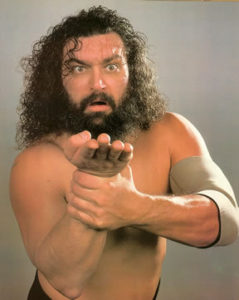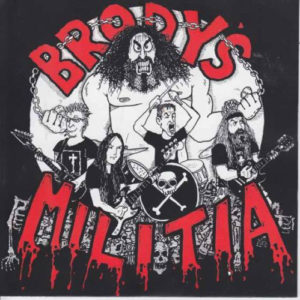
2018 is the 30th anniversary of Bruiser Brody’s murder. Fellow wrestler Jose Gonzalez, who competed as the masked Invader #1, stabbed him in a locker room ambush during an event for Puerto Rico’s World Wrestling Council (WWC) promotion. He might have held out longer had he not taken aspirin, which thinned his blood and made it more difficult to clot his wounds. Unfortunately, his ambulance didn’t make it to the hospital with enough time to save his life. Although Gonzalez was undeniably guilty, justice failed to serve in his trial—several witnesses received their subpoenas after it had already ended in an acquittal. Others never received them at all. Brody’s death cast a dark cloud over the exciting and intense Puerto Rican wrestling circuit, as much of the top American talent flat out refused to work there ever again. That was indicative of the respect he had among his peers, particularly those with reputations for being rebellious or assertive in their behind-the-scenes business matters.

I first read about Bruiser Brody in The Pictorial History of Wrestling. Despite being listed in the “good” section—chapters were divided up between the Good, the Bad & the Ugly—Brody looked like one of Hulk Hogan’s nightmares. He was every bit as big as the Hulkster was, but with an uncontrollable mane of dark hair and a beard. His forehead was covered in scar tissue; the result of many a bloody battle against opponents like Abdullah the Butcher. Every photo I saw of him in wrestling magazines just added more to his unsettling aura. I had the impression that a match against Bruiser Brody was comparable to a barroom brawl, if not a one-man riot. Unfortunately, he died before I could see him for myself—most of his exploits took place in regional promotions whose television product was out of my reach.
Much of Bruiser Brody’s legend occurred in All Japan Pro Wrestling, which is how I finally saw him in the ring for the first time thanks to various bootleg compilation videos. He was a HUGE star in Japan; even more than he was on this continent. Brody participated in the annual World’s Strongest Tag League tournament several times, collaborating in violence with an equally destructive force in Stan Hansen. They were unstoppable as a tag team, beating their foes to a bloody pulp and often taking on seemingly the entire All Japan locker room in the aftermath. Brody and Hansen would then fight their way out of the arena, turning the place into a virtual war zone in the process. These matches are part of adolescent memories in Japan like our favorite WWF or NWA moments from the same era. Fans nicknamed him “Choujyu”—Japanese for the Super Beast!
Brody made tens of thousands of dollars a week as one of All Japan’s top American heels and that dictated his business moves with promoters wherever else he wrestled. He wasn’t about to jeopardize his status for anyone who wasn’t on his level and he seldom lost. His presence was beneficial as long as the promoters paid Brody his due share. He would stir up trouble for a short time, in which a knock-down drag-‘em-out Brody brawl was usually a guaranteed draw. Brody would move on to the next territory before his act wore thin, always leaving the fans wanting more. Shady promoters who thought they could get over on the big guy found out otherwise—Brody would either no-show a big card or make sure the fans saw him in the arena before walking out. Many applauded him as one of the few wrestlers who stood up against the promoters while others felt that he screwed over his co-workers by costing them income in refunds. Neither side is wrong.
I have noticed a bit of a backlash against Bruiser Brody’s work from internet fans, particularly those whose tastes appear geared towards the modern self-conscious attempt at a “five-star match.” Whatever, guys. Professional wrestling was more about maintaining believability in Bruiser Brody’s era than it was about appealing to nerdy fans. Brody certainly did his part—would YOU have wanted to run into him in a dark alley? One thing I noticed right away when I first acquired those Japanese bootlegs was that many wrestlers had copied his style and demeanor over the years. Just look at Luke Harper for an example on today’s WWE roster. Although decades of imitators lessened the original’s effect to a degree, Brody still came off as quite formidable—particularly when he would charge into the crowd and send them running for cover as his trademark chain slashed at the air. You didn’t watch a Bruiser Brody match for the death-defying athletic prowess; you watched them for the violence and chaos.
My favorite Bruiser Brody match took place in St. Louis around 1982 or ’83 when he first challenged Ric Flair for the NWA world championship. He actually wrestled as King Kong Brody here in deference to the legendary Dick the Bruiser, a beloved star who drew big money in the St. Louis wrestling circuit. Filmed for Japanese television, this match was an epic best-of-three-falls encounter. Brody and Flair split the first two falls—Brody only lost when his opening-round assault on the Nature Boy resulted in a disqualification. However, the third fall would see both combatants go the distance without a decisive winner. Ric Flair remained the champion, but thousands of fans in attendance knew that King Kong Brody had him on the run. More importantly, there was the recognition from the NWA insiders who only saw him as a brawler lacking the ability to hang with the world champion for a compelling hour. You may not need a protractor to measure the flips from the top rope, but this down-and-dirty NWA title bout reaches all of its goals nonetheless—it’s a match that make professional wrestling worthy of calling it the True Sport of Kings in my book.
Confederacy of Scum co-founders Cocknoose and Rancid Vat have both immortalized the big man in song more than once. Cocknoose committed “Invader #1 Must Die” to their Badmen, Butchers & Bleeders LP, as well as a 45 with a decent cover of the Fabulous Freebirds’ Rock ‘n’ Wrestling classic “Badstreet USA” on the flip side. “Portrait of a Real American Hero” by Rancid Vat has been re-recorded frequently, but this noisy feedback-laden oddity is most notable on a split 7-inch with ANTiSEEN and their 31 Flavors of Hostility CD from 1996. Although he is never one of their lyrical topics, I’m also a big fan of Ohio thrash merchants Brody’s Militia who still appear to be shredding the eardrums of unappreciative audiences after more than fifteen years.

Bruiser Brody died without ever signing up for that big run with the WWF or WCW and fans have gone online with their fantasy scenarios of what could have been for years. I won’t be one of them, but it certainly would have been interesting to see him make that ascension. Bruiser Brody vs. Hulk Hogan never happened—a match I had thought about from the very first time I read The Pictorial History of Wrestling. Maybe that’s a good thing, as even my mind boggled at trying to think of a satisfying outcome. Brody certainly deserved better than merely being the Hulkster’s opponent of the month. Unfortunately, it has also resulted in minimal recognition from WWE’s version of wrestling history. YouTube and bootleg compilations like the great 5-disc DVD-R set from Highspots.com have proven to be the best way to view Bruiser Brody’s career. His posthumous entry into the Wrestling Observer’s Hall of Fame took place in 1996, but I’d like to see him inducted into WWE’s version before long. Make it happen, McMahon—your dad gave him his name in the first place and many of your wrestlers took cues from him and made a lot of money in the decades since his passing! HUSS! HUSS! HUSS! HUSS!

